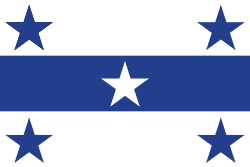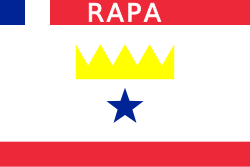- Flag of the Leeward Islands
- Sports Flag of the Leeward Islands
- Flag of the Tuamotu Archipelago
 Flag of French Polynesia | |
| Use | Civil and state flag |
|---|---|
| Proportion | 2:3 |
| Adopted | 23 November 1984 |
| Design | Two red horizontal bands encase a wide white band in a 1:2:1 ratio, with the Coat of arms centred on the white stripe |
| Le Tricolore | |
 | |
| Use | National flag, civil and state ensign |
| Proportion | 2:3 |
| Adopted | 15 February 1794 |
The flag of French Polynesia was adopted in 1984. [1] It is composed of two red horizontal bands, which encase a wide white band twice as wide as each red band, defaced with the Emblem of French Polynesia.
Contents
- Design
- Colours
- History
- Use
- Flags of component archipelagos
- Flags of the Society Islands
- Flags of the Tuamotu Archipelago
- Flags of the Austral Islands
- Historical flags
- See also
- References
- External links
Under the organic law on the status of French Polynesia, it is one of the "distinctive signs allowing the personality" of the country (fenua in Tahitian) to be marked "in official public events alongside the national emblem and the signs of the Republic". [2]






















